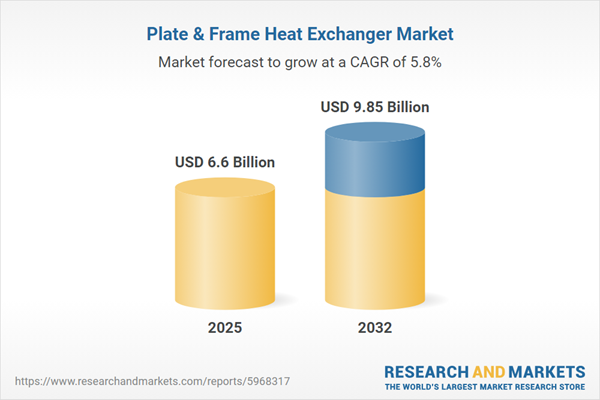Speak directly to the analyst to clarify any post sales queries you may have.
Plate and frame heat exchangers play a central role in driving operational efficiency and sustainable growth across process-intensive industries. Their adaptable design, material diversity, and enabling technologies make them vital to modern plant performance improvement strategies.
Market Snapshot: Plate & Frame Heat Exchanger Market
The Plate & Frame Heat Exchanger Market grew from USD 6.25 billion in 2024 to USD 6.60 billion in 2025. It is expected to continue growing at a CAGR of 5.84%, reaching USD 9.85 billion by 2032. This outlook highlights continued investment within energy, industrial, and manufacturing sectors, reflecting ongoing demand for compact, efficient heat transfer solutions that aid decarbonization and process optimization.
Scope & Segmentation
- Construction Types: Brazed, Gasketed Plate, Welded Plate
- Material Types: Carbon Steel, Copper Alloy, Nickel Alloy, Stainless Steel, Titanium
- End Use Industries: Chemical Processing (including Petrochemical and Specialty Chemicals), Food & Beverage (including Brewery, Dairy, Soft Drinks), Oil & Gas (covering Downstream, Midstream, Upstream), Pharmaceutical, Power Generation (including Nuclear, Renewable, and Thermal Power)
- Geographical Regions: Americas (including United States, Canada, Mexico, Brazil, Argentina, Chile, Colombia, Peru), Europe, Middle East & Africa (including United Kingdom, Germany, France, Russia, Italy, Spain, Netherlands, Sweden, Poland, Switzerland, United Arab Emirates, Saudi Arabia, Qatar, Turkey, Israel, South Africa, Nigeria, Egypt, Kenya), Asia-Pacific (including China, India, Japan, Australia, South Korea, Indonesia, Thailand, Malaysia, Singapore, Taiwan)
- Key Technologies: Digital monitoring and analytics platforms, additive manufacturing, gasketless and welded construction advances, bio-derived sealants, lightweight alloys
- Company Coverage: Alfa Laval AB, Danfoss A/S, Advanced Industrial Components Inc., API Heat Transfer Inc., Armstrong Fluid Technology, Boyd Corporation, Emerson Electric Co., Fischer Maschinen- und Apparatebau GmbH, FUNKE Wärmeaustauscher Apparatebau GmbH, GEA Group AG, Guntner (UK) Ltd, HISAKA WORKS LTD., HRS Heat Exchangers Ltd., Johnson Controls International PLC, KAORI HEAT TREATMENT CO. LTD., Lone Star Thermal Engineering, Onda S.p.A., SGL Carbon SE, SPX Flow Inc., Swep International AB, Thermax Ltd, Westinghouse Air Brake Technologies Corporation, Xi'an GU Heat Exchange Technology Service Co. Ltd., Xylem Inc.
Key Takeaways: Drivers and Strategic Insights
- Plate and frame heat exchangers support increasingly ambitious energy efficiency and emission reduction targets, with adoption accelerating in renewable power, circular manufacturing, and carbon-intensive sectors.
- Application flexibility is a market differentiator, as quick reconfiguration and compact design allow for plant retrofits, expansions, and scaling in both traditional and emerging process environments.
- Material selection is closely tied to application, spanning carbon steel for cost-based deployment to titanium and nickel alloys for aggressive or highly corrosive streams, directly shaping long-term asset performance.
- Digital transformation, featuring real-time sensor integration and predictive analytics, is improving equipment lifecycle management while enabling remote diagnostics, adaptive maintenance, and process optimization.
- Strategic alliances between solution providers and plant operators are deepening, shifting toward value-added lifecycle services and integrated project delivery, rather than one-off procurement.
- Aftermarket service models and rapid support frameworks are becoming key to supplier differentiation, especially for industries requiring high uptime or strict regulatory compliance.
Tariff Impact and Supply Chain Dynamics
The 2025 introduction of United States tariffs on key raw materials has triggered shifts in procurement and supply strategies. Manufacturers are rebalancing sourcing and increasing local production to offset increased input costs, while major end users are turning to larger inventory buffers. Supply chain risk mitigation, collaborative sourcing, and digital traceability are priorities to sustain reliability and cost control during policy changes.
Methodology & Data Sources
This report integrates comprehensive secondary research from technical literature, trade associations, and regulatory filings with in-depth primary interviews of OEM executives, plant engineers, and technical consultants. Triangulation across sources validates market insights, while expert reviews ensure accuracy and relevance of the findings.
Why This Report Matters
- Enables senior leaders to benchmark innovation, procurement resilience, and sustainability readiness against competitors globally.
- Delivers decision support for investment planning, technology evaluation, and partnership selection across complex regulatory and operational landscapes.
- Supports informed risk mitigation and market entry strategy for evolving commercial, tariff, and supply structures.
Conclusion
The Plate & Frame Heat Exchanger Market demonstrates resilience and growth through continuous innovation, material advances, and evolving supply strategies. Stakeholders leveraging digitalization, sustainable materials, and integrated service models are well positioned for long-term competitive advantage as industry standards and environmental expectations progress.
Additional Product Information:
- Purchase of this report includes 1 year online access with quarterly updates.
- This report can be updated on request. Please contact our Customer Experience team using the Ask a Question widget on our website.
Table of Contents
3. Executive Summary
4. Market Overview
7. Cumulative Impact of Artificial Intelligence 2025
Companies Mentioned
The companies profiled in this Plate & Frame Heat Exchanger market report include:- Alfa Laval AB
- Danfoss A/S
- Advanced Industrial Components Inc.
- API Heat Transfer Inc.
- Armstrong Fluid Technology
- Boyd Corporation
- Emerson Electric Co.
- Fischer Maschinen- und Apparatebau GmbH
- FUNKE Wärmeaustauscher Apparatebau GmbH by HYDAC Group
- GEA Group AG by Metallgesellschaft
- Guntner (UK) Ltd
- HISAKA WORKS, LTD.
- HRS Heat Exchangers Ltd.
- Johnson Controls International PLC
- KAORI HEAT TREATMENT CO., LTD.
- Lone Star Thermal Engineering
- Onda S.p.A.
- SGL Carbon SE
- SPX Flow, Inc.
- Swep International AB
- Thermax Ltd
- Westinghouse Air Brake Technologies Corporation
- Xi'an GU Heat Exchange Technology Service Co., Ltd.
- Xylem Inc.
Table Information
| Report Attribute | Details |
|---|---|
| No. of Pages | 185 |
| Published | November 2025 |
| Forecast Period | 2025 - 2032 |
| Estimated Market Value ( USD | $ 6.6 Billion |
| Forecasted Market Value ( USD | $ 9.85 Billion |
| Compound Annual Growth Rate | 5.8% |
| Regions Covered | Global |
| No. of Companies Mentioned | 25 |









